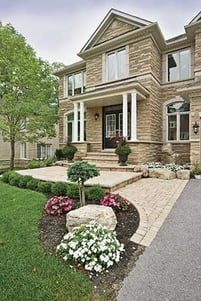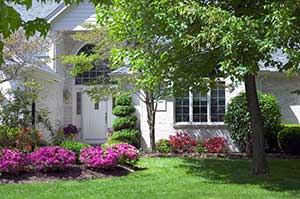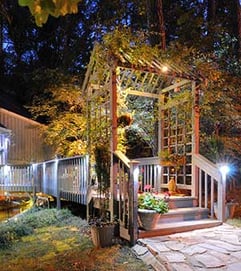Buying a home is one of the most significant financial decisions you’ll ever make, but the process...
6 Ways to Landscape Curb Appeal
Wait! Before you pull the car in your driveway, stop for a moment and study the place. The old adage about art could apply to curb appeal — we know it when we see it. What’s the verdict? Does your home have it? Getting curb appeal is largely a matter of elbow grease, and words won’t get the work done. That said, it sometimes pays to pause and remember the fundamentals that underlie the most appealing front yards.
"The most enormous thing in the garden is your house..."
- Leslie Land
-
Tend to the Elephant in the Yard
 The late Leslie Land, author and longtime gardening columnist for the New York Times, set out the foremost rule of landscaping for curb appeal: remember the house.
The late Leslie Land, author and longtime gardening columnist for the New York Times, set out the foremost rule of landscaping for curb appeal: remember the house.
As Land once told Better Homes & Gardens, “Rule No. 1, and the one that I see ignored a lot, is that — far and away — the most enormous thing in the garden is your house. … You have this enormous design limitation, and you need to design for curb appeal based on the size and shape of your house and how it relates to the street.”
From the colors and kinds of flowers and shrubs, to the size and style of elements such as fountains and arches, that elephant in the yard - your house - should be a determining factor. Be sure your landscaping design reflects this.
Beyond Leslie Land’s No. 1 rule, useful guidelines include:
-
Remember That More Is Better
-
Don't Go Overboard
There is such a thing as too much. At a certain point, vines grow from charming to out of control, and shrubs can become behemoths that might haunt a person’s dreams. Shape, prune and, if necessary, remove. No one is obligated to live forever with a landscaping mistake.
-
Do Your Research
 As a result, before adding anything to your front yard landscaping, do your research. Figure out which plants and trees thrive in your area, while also learning which species tend to grow out of control. If at all possible, avoid the plants that tend to overgrow in your region because this can reduce your workload.
As a result, before adding anything to your front yard landscaping, do your research. Figure out which plants and trees thrive in your area, while also learning which species tend to grow out of control. If at all possible, avoid the plants that tend to overgrow in your region because this can reduce your workload.
-
Have a Plan
It's also a good idea to map out where you will plant everything ahead of time and know how large the trees will be. That way, you can avoid placing too big of a plant in an area where it will eventually become cumbersome.
There’s likely no need for architect-like detail, and any plan is better than none. Avoid wasted work and costly mistakes by sketching the yard as it is and as you would like it to be. Seeing it all on paper can help focus your efforts as you make changes.
-
Think Ahead
 One of the best examples of the gardener’s art is a landscape that appeals year-round. With that in mind, envision your yard over a full 12 months. Come a frigid stretch or a hot, dry spell, what will add interest?
One of the best examples of the gardener’s art is a landscape that appeals year-round. With that in mind, envision your yard over a full 12 months. Come a frigid stretch or a hot, dry spell, what will add interest?
A Curb Appeal Quiz
Answering these questions can help point you in the right direction when landscaping to improve curb appeal:
- Can you see a clear path to the porch from the street? If not, it might be time to do some trimming or to remove sprawling shrubs.
- How does the path to your house look at night? Assess lighting at dusk. Is the path clearly lit? Replace burned out, broken or tipped over landscaping lights.
- Do you have a special feature to highlight? Give that stone pillar, fountain, etc. a low-voltage or solar spotlight.
- What’s missing from the porch? Boost color and texture with potted plants and hanging baskets. Hang a wreath to spruce up a lackluster front door. For an awkward empty space, consider adding a bench.
- How’s the mailbox looking these days? Is it time for a new one or a fresh coat of paint? Does it look lonely, in need of plantings or a sturdier post?

